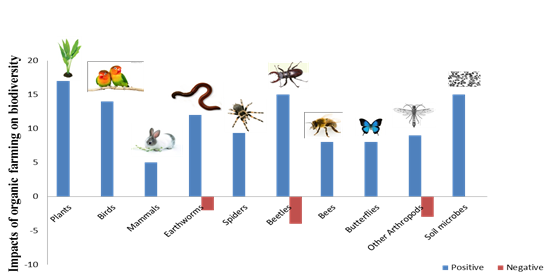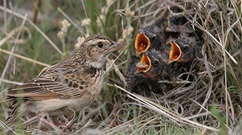Biodiversity can be defined as all sorts of life forms which encompass variety of plant, animal and other life in the world or in a particular habitat. Biodiversity has several levels such as Species diversity, genetic diversity and habitat or ecosystem diversity. Biodiversity is an essential component of nature and it ensures the survival of human species by providing food, fuel, shelter, medicines and other resources to mankind. The richness of biodiversity depends on the climatic conditions and area of the region and on the management strategies of any anthropogenically interfered system. A rich biological diversity is extremely required for maintaining natural biogeochemical processes, natural pest regulation, and pollination of flowers for fruits to be set and as well decomposition of organic matter.
The effect of organic farming has been a subject of interest for researchers since long time. Theory suggests that organic farming practices, which exclude the use of synthetic pesticides and fertilizers, would be beneficial for biodiversity, and this has proven true. Spanning all associated species, there is an average of 30% more on organic farms versus conventional farming methods.
In ancient farming practices, farmers did not possess the technology or manpower to have a significant impact on the destruction of biodiversity even at a stage of mass-production agriculture. Nowadays, common farming methods generally rely on pesticides to maintain high yields. With such, most agricultural landscapes favor mono-culture crops with very little flora or fauna co-existence. Modern organic farm practices such as the removal of pesticides and the inclusion of animal manure, crop rotation and multi-cultural crops provides the chance for larger biodiversity to thrive and coexist with harmony.
In several nations including India, their agricultural policies are increasingly promoting ecologically oriented farming methods that preserve biodiversity and conserve natural ecosystem processes. India is bestowed with lot of potential to produce all varieties of organic products as it has various agro climatic regions. Since ancient times, in several parts of the country, the inherited tradition of organic farming is an added advantage.
Organic farming and it’s benefit to Biodiversity:
Nearly all non-crops, naturally occurring species observed in comparative farm land practice studies show a preference in organic farming both by population and richness. Birds, butterflies, soil microbes, beetles, earthworms, spiders, vegetation, and mammals are particularly benefited. Organic crops have little or no herbicides and pesticides and thus biodiversity fitness and population density gets benefitted. Many weed species attract beneficial insects that improve soil qualities and forage on weed pests. Soil-bound organisms often benefits because of increased bacteria populations due to natural nutrient source spread such as manure, while experiencing reduced intake of herbicides and pesticides in comparison to common practices associated in conventional farming methods (Gabriel et al., 2007). Increased biodiversity, especially soil microbes such as mycorrhizae, have been proposed as an explanation for the high yields experienced by some organic farming practices, especially in light of the differences seen in a twenty one year’s comparison of organic and control fields.
Evidence of benefits of organic farming to biodiversity
There are several studies to show the biodiversity benefits of organic farming. In particular birds, predatory insects, spiders, soil microbes and field flora benefits most from organic farming managements (Figure. 1).

Figure. 1: Number of research articles/ studies that show organic farming having positive (Blue bars) and Negative (Red Bar) effects on biodiversity in comparison to conventional intensive agricultural practices. This Graph comprises summary of 99 research articles.
>> Many other studies published over the last decade demonstrate:
• Greater floral species richness and abundance within the crop, crop margins and non-farmed areas on organic farms.
• Up to six times more species within the crop on organic farms compared to conventional farms.
• More frequent occurrence of rare arable species on organic farms.
• Positive effect of organic farming on insect species richness. Higher abundance of predatory insects but lower abundance of non-predatory insects and pests in organic systems.
• Average activity density of carabids, staphylinids and spiders in organic systems almost twice that of conventional systems. Higher abundance and greater species richness of ground beetles in organic fields. Organic farming enhanced abundance of spiders by 62% compared to conventional systems.
• Higher bee diversity recorded in organic fields.
• Species richness and abundance of butterflies higher in organic than in conventional systems in simple landscapes. The amount of organic farming in the surrounding landscape increases butterfly species richness on nearby conventional land.
• Significantly higher abundance of non-pest butterfly species on organic farms (up to twice that of conventional farms); no difference between organic and conventional systems in abundance of two pest species (large white and small white).
• Soil microbial biomass and activity higher in organic systems.
• Root length colonised by mycorrhizae was 40% higher in organic than in conventional systems. Arbuscular mycorrhizal fungi (AMF) spore abundance and species diversity was significantly higher in organic than conventional systems.
• AMF species richness increased significantly with time since conversion to organic practices.
• Biomass and abundance of earthworms were higher by a factor of 1.3 to 3.2 in organic plots.
• General trend for higher earthworm abundance and species richness in organic systems was noticed, although some studies have shown lower abundance in organic arable fields, probably as a result of excessive tillage.
• More birdlife biodiversity had been observed. Few ground nesting birds like sky larks can only survive in less intensive farming system like organic farming system. ]

Ground nesting birds like sky lark can only thrive in a less intensively cultivated land
• Species richness of passerine birds, particularly invertebrate feeders, was higher in organic systems in simple landscapes. Species richness of non-passerines was positively related to organic farming independent of landscape complexity. This suggests that invertebrate feeders are in particular benefit from organic systems in simple landscapes due to increased food resources (invertebrates).
• Activity levels of small mammals (wood mouse, bank vole and common shrew) greater in organic than conventional fields.
• Total bat activity and foraging activity was significantly higher on organic farms by 61% and 84% respectively.

Enhanced biodiversity in organic farming system promotes self regulation and biocontrol mechanism
Conclusion:
There is now a large body of evidence that in several areas, organic farming supports much greater levels to both wildlife abundance and other diversity than conventional farming systems. This includes those plant and animal groups that are known to have significantly declination on intensively cultivated inorganic farmland in recent years.
References
1. Gabriel, D., and Tscharntke, T. (2007) Insect pollinated plants benefit from organic farming. Agriculture, Ecosystems and Environment 118: 43-48.
2. Holzschuh A, Steffan-Dewenter I, Kleijn D, Tscharntke T (2007) Diversity of flowervisiting bees in cereal fields: effects of farming system, landscape composition and regional context. Journal of Applied Ecology 44:41-49.
3. Rundlof M, Bengtsson J, Smith HG (2008) Local and landscape effects of organic farming on butterfly species richness and abundance. Journal of Applied Ecology 45:813-820.
4. Smith HG, Danhardt J, Lindstrom A, Rundlof M (2010) Consequences of organic farming and landscape heterogeneity for species richness and abundance of farmland birds. Oecologia 162:1071-1079.
5. Verbruggen E, Roling WFM, Gamper HA, Kowalchuk GA, Verhoef HA, van der Heijden MGA (2010) Positive effects of organic farming on below-ground mutualists: large-scale comparison of mycorrhizal fungal communities in agricultural soils. New Phytologist 186:968-979.
About Author / Additional Info:
Scientist at CESCRA, ICAR-Indian Agricultural Research Institute, New Delhi